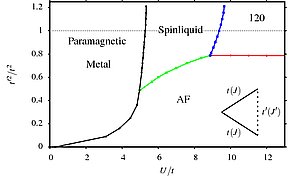P2
Many-body effects in the electronic structure and the superconductivity of adsorbates on semiconductor surfaces

W. Hanke and E. Hankiewicz
This project continues and extends our study of many-body effects in the electronic structure and emerging phases of adsorbates on semiconductor surfaces. The variation of coverage/doping allows for a controlled study of electronic correlations beyond traditional band theory in competition with geometrical frustration (triangular lattice). In the first period, on the basis of progress in methodology (LDA + Variational Cluster Approaches, LDA + DMFT, QMC, Functional Renormalization Group), we concentrated on the Mott transition and predicted the underlying geometrical and emerging magnetic orders in specific adatomic systems. In close collaboration with project P1, the fingerprints of this magnetic order were identified in spectroscopies, such as the corresponding photoemission spectra.
In the continuation, we would like to (i) address possible spin-liquid phases and (ii) systematically extend our studies to superconductivity such as the recently detected superconductivity in the Pb(In) on Si(111). Here, questions of general interest are the fragile nature of a possible 2D superconducting state, susceptible to strong quantum-phase fluctuations and the glue for Cooper-pairing.
Furthermore, we concentrate on (iii) the role of spin-orbit coupling and (iv) new paths to unconventional topological superconductivity (SC). Part (iii) is motivated from our findings (with P1) for the Au/Ge system with its strong-spin orbit coupling, where a striking similarity was detected to the surface Dirac state of the topological insulator Bi2Te3. In Part (iv), we focus on chiral SC with a complex pairing gap and time-reversal symmetry breaking. This non-trivial topology has an exceptionally rich phenomenology such as a quantum-spin and thermal Hall conductance as well as edge currents, which, together with the complex pairing gap, can be searched for in experiments. Last but not least, we want to study the combination of strong spin-orbit coupling and SC, and investigate whether the exciting possibility of pairing (singlet + triplet) mixing can be realized in adatom systems.

